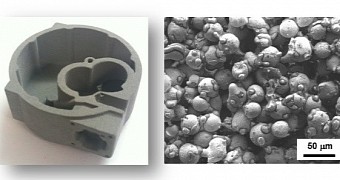Crystals have been a staple of science fiction and fantasy fiction for a long time, used for everything from beautification to power sources and memory repositories. Now, 3D printing tech is gaining the ability to create objects made from crystal.
Of course, that's not a completely accurate way to put it, since the only reliable way currently known to make more crystals with specific properties or shapes is to literally grow them. Not counting mining for them, obviously.
However, 3D printing experts wanted there to be an option to create objects that at least looked like they were made of crystal.
Their solution was to create a new material that can be used in SLS (selective laser sintering) printers.
Quasicrystals and metal alloys have been combined
Quasicrystal is actually the layman term (after a fashion) for a structure that is ordered but not periodic, a pattern that can continuously fill all available space, but lacking in translational symmetry.
Their most important advantage is that they have high inner strength while keeping a pretty low density.
Complex Metal Alloys (CMA), meanwhile, have high resistance to wear and corrosion and low friction, but are otherwise quite brittle.
A new type of CMA has been created now, which incorporates quasicrystals, and because of that, has mechanical properties alike those of steel and brass, but with the added benefit of a much lower density.
This set of assets can become key in the additive manufacturing of parts that are stronger, much more stress-resistant than those that can be 3D printing with current methods and materials.
CMAs were considered before, but as we said, all the options available were brittle at best, preventing their implementation on large scales. By combining them with metal alloys, though, the weaknesses are offset.
Samuel Kenzari, David Bonina, Jean Marie Dubois, and Vincent Fournée of the University of Lorraine are the ones who determined that the polymer matrix composites currently in use in 3D printing could be strengthened with quasicrystals.
Applications of the new quasicrystal CMA
Car and aircraft makers are among the first who will adopt the material, as it will allow them to 3D print full car bodies and airplane parts that are not only strong but lightweight as well. Since lower weight also leads to better fuel efficiency, that will further increase the appeal.
The only thing we can possibly mourn here is that, quasicrystals or no, the materials are still metal alloys, so the cars and airplanes won't look like actual crystals. Alas.

 14 DAY TRIAL //
14 DAY TRIAL //